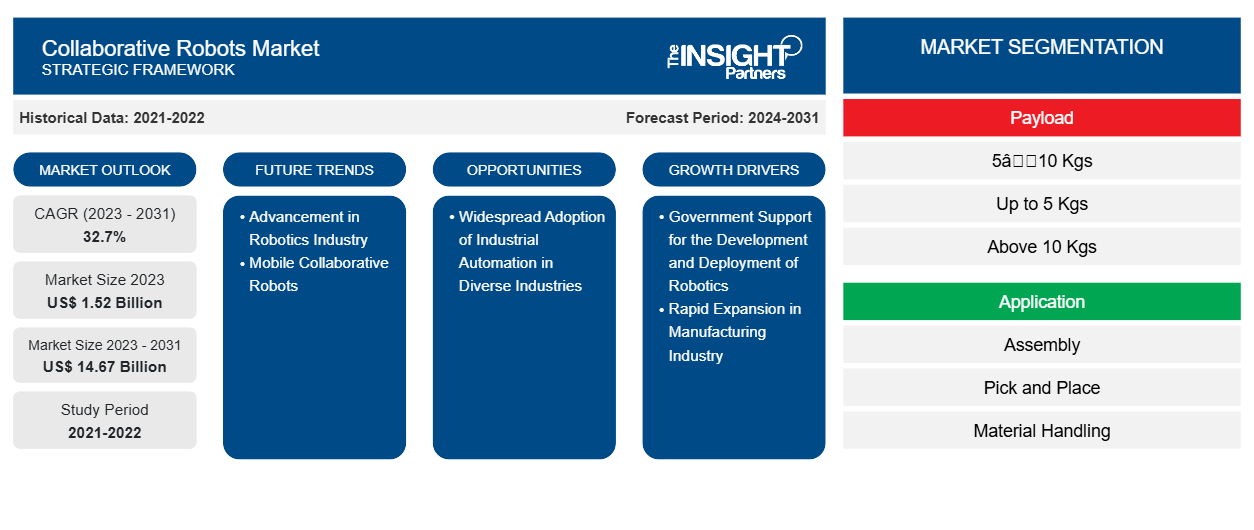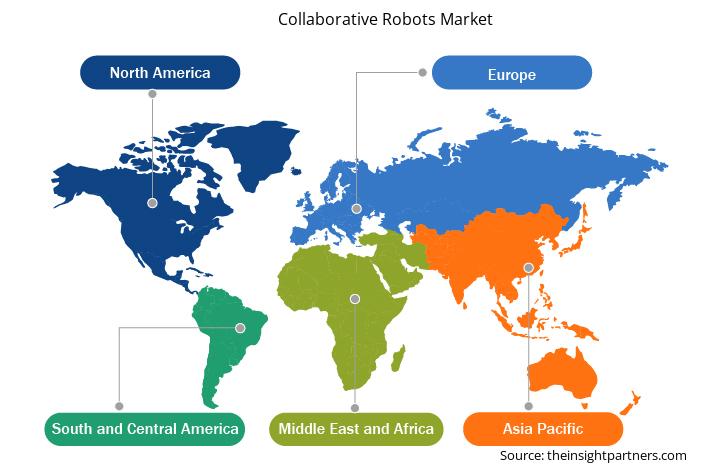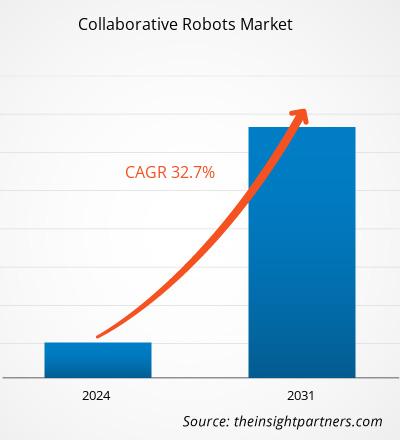Se proyecta que el tamaño del mercado de robots colaborativos alcance los 14.670 millones de dólares estadounidenses para 2031, frente a los 1.880 millones de dólares estadounidenses de 2024. Se espera que el mercado registre una tasa de crecimiento anual compuesta (TCAC) del 35,7 % entre 2025 y 2031. Es probable que los robots colaborativos móviles impulsen nuevas tendencias en el mercado.
Análisis del mercado de robots colaborativos
Los robots colaborativos son un segmento de robots de servicio que se utilizan en la manipulación de materiales, la fabricación y los laboratorios. La creciente demanda en las fábricas, especialmente en el sector manufacturero, donde humanos y robots ya han comenzado a trabajar en armonía, está generando un crecimiento en el mercado de los robots colaborativos . La llegada de los robots colaborativos ha propiciado un entorno de trabajo confiable donde las personas pueden trabajar con seguridad junto a los robots. Los factores clave que impulsan este mercado incluyen el apoyo gubernamental al desarrollo y la implementación de la robótica y la rápida expansión de la industria manufacturera.
Descripción general del mercado de robots colaborativos
El panorama industrial está experimentando una transformación significativa, impulsada en gran medida por el auge de los robots colaborativos: máquinas avanzadas diseñadas para trabajar de forma segura y eficaz junto a los humanos. Estos robots se están convirtiendo en compañeros de equipo inteligentes que mejoran la seguridad, impulsan la productividad y promueven operaciones sostenibles. Al operar a velocidades equivalentes a las humanas, los robots colaborativos simplifican la evaluación de riesgos relacionados con el movimiento, lo que facilita que los operadores cercanos eviten el contacto involuntario.
Los gobiernos de varias naciones del mundo están tomando iniciativas para apoyar y promover el desarrollo y la adopción de la robótica en sus respectivos países. Se espera que estas iniciativas y medidas gubernamentales impulsen el crecimiento del mercado de la robótica industrial a nivel mundial, impulsando así también la demanda de robots colaborativos. En 2022, Europa registró la mayor cuota de ingresos del mercado mundial de robots colaborativos. En Europa, se prevé que el sólido sector automovilístico y la presencia de importantes fabricantes de automóviles de alta gama impulsen el mercado de los robots colaborativos. Además, se prevé que el crecimiento de la fabricación de vehículos eléctricos impulse el crecimiento del mercado de los robots colaborativos.
Recibirá personalización de cualquier informe, sin cargo, incluidas partes de este informe o análisis a nivel de país, paquete de datos de Excel, así como también grandes ofertas y descuentos para empresas emergentes y universidades.
Mercado de robots colaborativos: perspectivas estratégicas

-
Obtenga las principales tendencias clave del mercado de este informe.Esta muestra GRATUITA incluirá análisis de datos, desde tendencias del mercado hasta estimaciones y pronósticos.
Impulsores y oportunidades del mercado de robots colaborativos
Apoyo gubernamental al desarrollo y despliegue de la robótica
Los gobiernos de varias naciones del mundo están tomando iniciativas para apoyar y promover el desarrollo y la adopción de la robótica en sus respectivos países. Por ejemplo, el gobierno de Singapur, en el marco de su Programa de Transformación Industrial, anunció diversas medidas para facilitar la innovación, la automatización y la expansión de las empresas, así como la obtención de financiación. El gobierno de la India ha adoptado diversas medidas para impulsar la fabricación inteligente en el país, incluyendo el programa de Incentivos Vinculados a la Producción (PLI). Como una importante iniciativa gubernamental para promover la fabricación en la India, el programa PLI se lanzó en 2020 y abarcó 14 sectores, entre ellos la automoción, el farmacéutico, el textil, el procesamiento de alimentos y los electrodomésticos. Asimismo, el gobierno de China ha adoptado diversas medidas para la implementación de la robótica industrial en el sector manufacturero del país. Esto incluye el plan "Hecho en China 2025" para el desarrollo de industrias de alta tecnología. Asimismo, el gobierno anunció un "Plan de Desarrollo de la Industria Robótica" quinquenal para la expansión del sector de la robótica industrial en China. El gobierno ofrece importantes subsidios y exenciones fiscales para la automatización industrial. Además, la iniciativa Industria 4.0 de Alemania incluye el desarrollo y la implementación de robots industriales. El gobierno anunció la oferta de subvenciones no reembolsables en efectivo por aproximadamente US$78 millones anuales para apoyar a institutos de investigación, empresas y académicos durante el período 2016-2020 en la investigación sobre la interacción humano-tecnología. Actualmente, el gobierno ha puesto a disposición aproximadamente 300 programas de estudio relacionados con la automatización y la robótica.
El gobierno surcoreano anunció un plan de inversión de 2,7 millones de dólares estadounidenses, el Segundo Plan Básico para el Desarrollo de Robots Inteligentes (2014-2018). Tras la finalización del Segundo Plan Básico (2014-2018), el gobierno formuló e implementó el Tercer Plan Básico para el Desarrollo de Robots Inteligentes (2019-2023).
Rápida expansión en la industria manufacturera
El panorama industrial ha evolucionado enormemente en los últimos tiempos, con los robots colaborativos desempeñando un papel fundamental en la generación de cambios significativos. A diferencia de los robots tradicionales, los cobots están diseñados para trabajar junto a los humanos, y su programación suele incluir medidas de seguridad que requieren la colaboración humana, lo que limita su funcionamiento independiente. A pesar de ello, los cobots ofrecen importantes mejoras de productividad, a la vez que mejoran la seguridad en el trabajo, permitiendo operaciones más flexibles y rentables. Se han convertido en componentes vitales de las industrias modernas, expandiendo su presencia más allá de la fabricación para incluir centros logísticos y sanitarios de todo el mundo.
En el sector manufacturero, los cobots se utilizan ampliamente para tareas de ensamblaje, soldadura, control de maquinaria y empaquetado o paletizado. Su capacidad para realizar operaciones repetitivas y precisas mejora la calidad del producto y reduce la fatiga de los empleados. Al automatizar tareas rutinarias, los cobots permiten a los trabajadores concentrarse en actividades de mayor valor, lo que en última instancia mejora la productividad, la eficiencia y la seguridad laboral en todas las operaciones de fabricación. La industria manufacturera global se encuentra en rápida expansión, con nuevas regiones invirtiendo en plantas de fabricación. Esta expansión fomenta la innovación tecnológica para mejorar la productividad de la planta, mantener una ventaja competitiva y mantener una ventaja competitiva. Por lo tanto, la rápida expansión de la industria manufacturera impulsa la demanda global de robots colaborativos.
Análisis de segmentación del informe de mercado de robots colaborativos
Los segmentos clave que contribuyeron a la derivación del análisis del mercado de robots colaborativos son la carga útil, la aplicación, el tipo, la industria del usuario final y la funcionalidad.
- Según la carga útil, el mercado se segmenta en 5-10 kg, hasta 5 kg y más de 10 kg. El segmento de 5-10 kg tuvo la mayor cuota de mercado en 2024.
- Según la aplicación, el mercado se clasifica en ensamblaje, pick and place, manejo de materiales, pruebas de calidad, manejo de maquinaria, soldadura, empaquetado y otros. El segmento de ensamblaje tuvo la mayor participación de mercado en 2024.
- Por tipo, el mercado se divide en brazos robóticos, pistolas de soldadura, pinzas y otros. El segmento de brazos robóticos tuvo la mayor participación de mercado en 2024.
- Por industria de usuario final, el mercado se segmenta en automoción, electrónica, metalmecánica, alimentación y bebidas, logística, farmacéutica, entre otros. El segmento automotor dominó el mercado en 2024.
- Por funcionalidad, el mercado se divide en robots estáticos y móviles. El segmento de robots estáticos dominó el mercado en 2024.
Análisis de la cuota de mercado de robots colaborativos por geografía
El alcance geográfico del informe del mercado de robots colaborativos se divide principalmente en cinco regiones: América del Norte, Asia Pacífico, Europa, Medio Oriente y África, y América del Sur y Central.
Asia Pacífico tuvo una cuota de mercado significativa en robots colaborativos en 2024. Esta región está compuesta por numerosos países en desarrollo que experimentaron un crecimiento significativo en su sector manufacturero. Se ha convertido en un centro mundial de fabricación con la presencia de diversas industrias manufactureras. Si bien China se ha convertido en un centro de manufactura de alta cualificación, economías emergentes como India, Corea del Sur, Taiwán y Vietnam atraen cada vez más empresas que buscan reubicar operaciones de manufactura de baja a media cualificación. Estos países ofrecen costos laborales competitivos y promueven activamente la inversión extranjera directa mediante iniciativas gubernamentales de apoyo. Sin embargo, para consolidar su posición como destinos líderes de manufactura en la región, estas naciones deben abordar desafíos como la escasez de mano de obra cualificada, los bajos niveles de productividad y el subdesarrollo de las infraestructuras.
Los gobiernos de las economías en desarrollo de Asia Pacífico ofrecen devoluciones fiscales, fondos, subsidios y otras ayudas para atraer a empresas manufactureras a establecer sus plantas en sus respectivos países. Además, varios gobiernos han implementado iniciativas como "Hecho en China 2025" y "Hecho en India". Sin embargo, China, el mayor centro manufacturero, está experimentando un aumento en el costo laboral debido al envejecimiento de su población. Esto ha llevado a las empresas manufactureras a buscar inversiones en países del Sudeste Asiático. La mejora de la infraestructura, el aumento del consumo interno y la reducción de costos son algunos de los factores que atraen a las empresas manufactureras a estos países.
China es el mayor productor mundial de automóviles. Japón, India y Corea del Sur son otros importantes países fabricantes de vehículos en Asia Pacífico. Además de la industria automotriz, varias otras industrias en China están implementando robots colaborativos; por ejemplo, en Xiamen Runner Industrial Corporation, uno de los mayores fabricantes de accesorios de baño de China, se desplegaron 64 robots de Universal Robots en la línea de producción para diversas tareas, desde la atención y el moldeo por inyección de máquinas hasta el ensamblaje del producto.
Perspectivas regionales del mercado de robots colaborativos
Los analistas de Insight Partners han explicado detalladamente las tendencias y los factores regionales que influyen en el mercado de robots colaborativos durante el período de pronóstico. Esta sección también analiza los segmentos y la geografía del mercado de robots colaborativos en América del Norte, Europa, Asia Pacífico, Oriente Medio y África, y América del Sur y Central.

- Obtenga los datos regionales específicos para el mercado de robots colaborativos
Alcance del informe de mercado de robots colaborativos
| Atributo del informe | Detalles |
|---|---|
| Tamaño del mercado en 2025 | US$ 1.88 mil millones |
| Tamaño del mercado en 2031 | US$ 14.67 mil millones |
| CAGR global (2025-2031) | 35,7% |
| Datos históricos | 2021-2023 |
| Período de pronóstico | 2025-2031 |
| Segmentos cubiertos |
Por carga útil
|
| Regiones y países cubiertos |
América del norte
|
| Líderes del mercado y perfiles de empresas clave |
|
Densidad de actores del mercado de robots colaborativos: comprensión de su impacto en la dinámica empresarial
El mercado de robots colaborativos está creciendo rápidamente, impulsado por la creciente demanda de los usuarios finales debido a factores como la evolución de las preferencias de los consumidores, los avances tecnológicos y una mayor conciencia de los beneficios del producto. A medida que aumenta la demanda, las empresas amplían su oferta, innovan para satisfacer las necesidades de los consumidores y aprovechan las tendencias emergentes, lo que impulsa aún más el crecimiento del mercado.
La densidad de actores del mercado se refiere a la distribución de empresas o compañías que operan en un mercado o sector en particular. Indica cuántos competidores (actores del mercado) hay en un mercado determinado en relación con su tamaño o valor total.
Las principales empresas que operan en el mercado de robots colaborativos son:
- Kuka AG
- Yaskawa América Inc.
- Aubo (Pekín) Robotics Technology Co. Ltd.
- Doosan Robotics Inc
- Corporación Fanuc
- ABB Ltd
Descargo de responsabilidad : Las empresas enumeradas anteriormente no están clasificadas en ningún orden particular.

- Obtenga una descripción general de los principales actores clave del mercado de robots colaborativos
Noticias y desarrollos recientes del mercado de robots colaborativos
El mercado de robots colaborativos se evalúa mediante la recopilación de datos cualitativos y cuantitativos tras investigaciones primarias y secundarias, que incluyen importantes publicaciones corporativas, datos de asociaciones y bases de datos. A continuación, se enumeran algunos de los avances en el mercado de robots colaborativos:
- OMRON ha anunciado la disponibilidad de los robots colaborativos OMRON Serie TM S, diseñados para diversas aplicaciones en múltiples industrias. Estos cobots incorporan hardware avanzado, más funciones y certificaciones de seguridad, y capacidades de configuración de última generación, lo que los hace más fáciles de usar que nunca. (Fuente: OMRON, Comunicado de prensa, septiembre de 2024)
- TÜV Rheinland Group, organización independiente líder a nivel internacional en pruebas, inspección y certificación, emitió el Certificado CE de Conformidad con la Directiva de Maquinaria y Seguridad Funcional para los productos ESS (ESTUN Safety Solution) a ESTUN Automation Co., Ltd. Esto demuestra el rápido progreso de ESTUN en el desarrollo de un sistema integral de seguridad funcional para productos robóticos. Esta certificación no solo demuestra la capacidad innovadora y el nivel profesional de ESTUN en el campo de la tecnología robótica, sino que también refleja su estricto control y compromiso con la seguridad y la calidad de los productos, y mejorará aún más la calidad y la eficiencia del servicio de ESTUN en el mercado global. (Fuente: ESTUN Robotics, comunicado de prensa, abril de 2024)
Cobertura y resultados del informe de mercado sobre robots colaborativos
El informe "Tamaño y pronóstico del mercado de robots colaborativos (2021-2031)" ofrece un análisis detallado del mercado que abarca las siguientes áreas:
- Tamaño del mercado de robots colaborativos y pronóstico a nivel global, regional y nacional para todos los segmentos clave del mercado cubiertos bajo el alcance
- Tendencias del mercado de robots colaborativos, así como dinámicas del mercado como impulsores, restricciones y oportunidades clave
- Análisis PEST y FODA detallado
- Análisis del mercado de robots colaborativos que abarca las tendencias clave del mercado, el marco global y regional, los principales actores, las regulaciones y los desarrollos recientes del mercado.
- Análisis del panorama industrial y de la competencia que abarca la concentración del mercado, el análisis de mapas de calor, los actores destacados y los desarrollos recientes del mercado de robots colaborativos.
- Perfiles detallados de empresas
- Análisis histórico (2 años), año base, pronóstico (7 años) con CAGR
- Análisis PEST y FODA
- Tamaño del mercado, valor/volumen: global, regional y nacional
- Industria y panorama competitivo
- Conjunto de datos de Excel
Informes recientes
Testimonios
Razón para comprar
- Toma de decisiones informada
- Comprensión de la dinámica del mercado
- Análisis competitivo
- Información sobre clientes
- Pronósticos del mercado
- Mitigación de riesgos
- Planificación estratégica
- Justificación de la inversión
- Identificación de mercados emergentes
- Mejora de las estrategias de marketing
- Impulso de la eficiencia operativa
- Alineación con las tendencias regulatorias






















 Obtenga una muestra gratuita para - Mercado de robots colaborativos
Obtenga una muestra gratuita para - Mercado de robots colaborativos